Seismicity Before and After the 2023 M7.7 and M7.5 Turkey Quakes
Abstract
1. Introduction
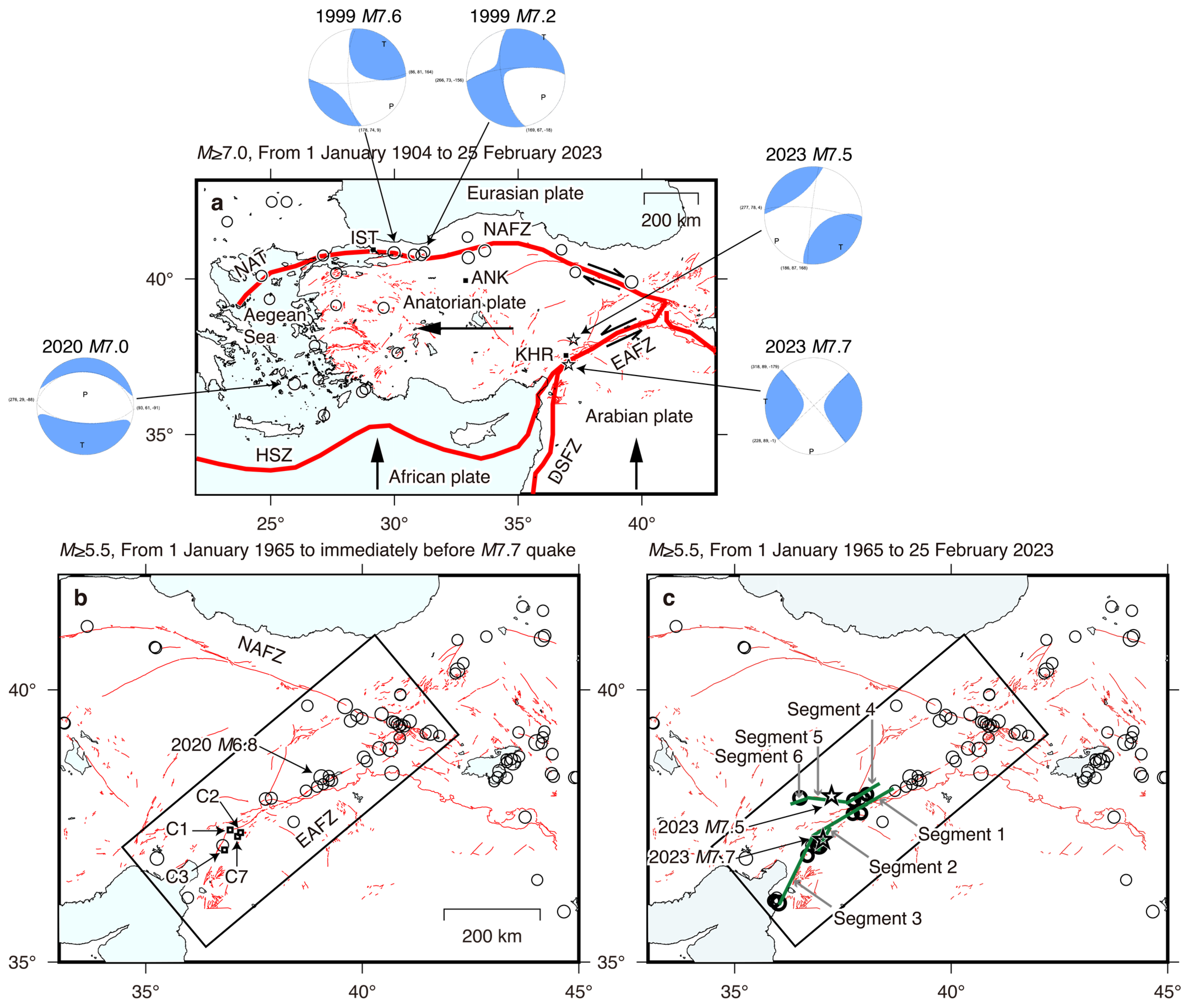
2. Research Area Background
3. Methods
3.1. OU Relation and ETAS Model
3.2. GR Relation
3.3. Stress Change Calculation
4. Data
4.1. Quake Catalogs
4.2. Fault Models
5. Results
5.1. Pre-Doublet-Quake Sequence
5.1.1. b Value and Change in Seismicity Rate
5.1.2. Background Activity and Clustering Activity
5.1.3. Slip Distribution of the M7.7 Quake and Preceding Seismicity
5.2. Post-Doublet-Quake Sequence
5.2.1. Seismicity Immediately After the Doublet Quakes
5.2.2. Seismicity Until the M6.4 Quake
5.2.3. Seismicity Until the M5.9 Quake
6. Discussion
7. Conclusions
- Seismicity transients began in mid-2022 within 50 km of the future M7.7 epicenter. We revealed that the occurrence rate after mid-2022 was significantly larger than that before it, showing seismic activation. Small b values were observed after the start of activation. The transients reported previously [10,11] were confirmed by our study, which applied the ETAS model and the Bayesian b-value model to events in two different quake catalogs.
- Seismicity within 50 km of the future M7.7 epicenter decomposed into two types of activity: background and clustering. The parameter representing background activity was almost constant over time, while that representing clustering activity was smaller before the start of activation than after it. Seismic activation is interpreted as the effect of clustering activity. This was attributed to the emergence of two clusters near the future M7.7 epicenter [10].
- A high-slip area on the segment (referred to as segment 2 in this study) from which the M7.7 rupture started overlaps with seismicity after the start of activation. This seismicity mostly consisted of events of the cluster displaying low b values. A similar result was observed for the 2011 Tohoku megaquake [30], where a correlation between areas of low b values and areas of large co-seismic displacement was shown. A cluster of high b values that emerged in 2017–2018 overlapped with a low-slip area on the same segment.
- Seismicity following the 2020 M6.8 quake suggests that the north end of the M7.7 rupture was close to the south end of the M6.8 rupture. There was a lack of post-M7.5-quake seismic activity at the zone of increase in Coulomb stress imparted by the doublet quakes beyond the north end of the M7.7 rupture, noting that this area, which lacked seismic activity, coincided with the area of the 2020 M6.8 rupture. Our result is consistent with a previous finding [5].
- Locations of the two M6-class quakes around the north and south ends of the M7.7-quake rupture were in relatively high-stress regions compared with the surrounding ones, as implied by the b-value and Coulomb-stress analyses. The region around the hypocenters of the M6-class quakes became closer to failure by the doublet quakes. A similar result was obtained when adding the 2020 M6.8 fault to source faults of Coulomb stress changes.
- The decay of seismic activity with time after the M7.7 quake around the causative faults was well modeled by the standard (single) ETAS model, indicating no pronounced activation or quiescence. This decay also followed the OU relation. Our estimation of the duration of the post-doublet-quake sequence was 1–2 × 103 days (2.7–5.5 years), a longer duration than that proposed by an earlier study [5]. The difference between the present study and the previous study emerged from the fact that the former used events within 618 days since the M7.7 quake while the latter used events within about 100 days.
Supplementary Materials
Author Contributions
Funding
Data Availability Statement
Acknowledgments
Conflicts of Interest
Abbreviations
| AFAD | Disaster and Emergency Management Authority |
| AIC | Akaike Information Criterion |
| ANK | Ankara |
| DSFZ | Dead Sea fault zone |
| EAFZ | East Anatolian fault zone |
| ETAS | Epidemic-Type Aftershock Sequence |
| GR | Gutenberg–Richter |
| HSZ | Hellenic subduction zone |
| IST | Istanbul |
| KHR | Kahramanmaraş |
| KOERI | Kandilli Observatory and Earthquake Research Institute |
| NAFZ | North Anatolian fault zone |
| NAT | North Aegean Trough |
| NP | nodal plane |
| OU | Omori–Utsu |
| USGS | United States Geological Survey |
References
- USGS. The 2023 Kahramanmaraş, Turkey, Earthquake Sequence. 2024. Available online: https://earthquake.usgs.gov/storymap/index-turkey2023.html (accessed on 17 March 2025).
- USGS. M7.8-Pazarcik Earthquake, Kahramanmaras Earthquake Sequence. 2023. Available online: https://earthquake.usgs.gov/earthquakes/eventpage/us6000jllz/executive (accessed on 17 March 2025).
- USGS. M7.5-Elbistan Earthquake, Kahramanmaras Earthquake Sequence. 2023. Available online: https://earthquake.usgs.gov/earthquakes/eventpage/us6000jlqa/executive (accessed on 17 March 2025).
- USGS. M6.7-13 km N of Doğanyol, Turkey. 2020. Available online: https://earthquake.usgs.gov/earthquakes/eventpage/us60007ewc/executive (accessed on 17 March 2025).
- Toda, S.; Stein, R. The role of stress transfer in rupture nucleation and inhibition in the 2023 Kahramanmaraş, Türkiye, sequence, and a one-year earthquake forecast. Seismol. Res. Lett. 2024, 95, 596–606. [Google Scholar] [CrossRef]
- Chen, J.; Liu, C.; Dal Zilio, L.; Cao, J.; Wang, H.; Yang, G.; Göğüş, O.H.; Zhang, H.; Shi, Y. Decoding Stress Patterns of the 2023 Türkiye-Syria Earthquake Doublet. J. Geophys. Res. 2024, 129, e2024JB029213. [Google Scholar] [CrossRef]
- Toda, S.; Stein, R.S.; Özbakir, A.D.; Gonzalez-Huizar, H.; Sevilgen, V.; Lotto, G.; Sevilgen, S. Stress change calculations provide clues to aftershocks in 2023 Türkiye earthquakes. Temblor 2023. [Google Scholar] [CrossRef]
- Kobayashi, T.; Munekane, H.; Kuwahara, M.; Furui, H. Insights on the 2023 Kahramanmaraş Earthquake, Turkey, from InSAR: Fault locations, rupture styles and induced deformation. Geophys. J. Int. 2024, 236, 1068–1088. [Google Scholar] [CrossRef]
- Ren, C.; Wang, Z.; Taymaz, T.; Hu, N.; Luo, H.; Zhao, Z.; Yue, H.; Song, X.; Shen, Z.; Xu, H.; et al. Supershear triggering and cascading fault ruptures of the 2023 Kahramanmaraş, Türkiye, earthquake doublet. Science 2024, 383, 305–311. [Google Scholar] [CrossRef] [PubMed]
- Kwiatek, G.; Martínez-Garzón, P.; Becker, D.; Dresen, G.; Cotton, F.; Beroza, G.C.; Acarel, D.; Ergintav, S.; Bohnhoff, M. Months-long seismicity transients preceding the 2023 MW 7.8 Kahramanmaraş earthquake, Türkiye. Nat. Commun. 2023, 14, 7534. [Google Scholar] [CrossRef]
- Över, S.; Demirci, A.; Özden, S. Tectonic implications of the February 2023 Earthquakes (Mw7.7, 7.6 and 6.3) in south-eastern Türkiye. Tectonophysics 2023, 866, 230058. [Google Scholar] [CrossRef]
- Gutenberg, B.; Richter, C.F. Frequency of earthquakes in California. Bull. Seismol. Soc. Am. 1944, 34, 185–188. [Google Scholar] [CrossRef]
- USGS. M6.3-2 km NNW of Uzunbağ, Turkey. 2023. Available online: https://earthquake.usgs.gov/earthquakes/eventpage/us6000jqcn/executive (accessed on 17 March 2025).
- USGS. M6.0-19 km W of Doğanyol, Turkey. 2024. Available online: https://earthquake.usgs.gov/earthquakes/eventpage/us6000nyzk/executive (accessed on 17 March 2025).
- Utsu, T. A statistical study on the occurrence of aftershocks. Geophys. Mag. 1961, 30, 521–605. [Google Scholar]
- Lomax, A. Precise, NLL-SSST-Coherence Hypocenter Catalog for the 2023 Mw 7.8 and Mw 7.6 SE Turkey Earthquake Sequence. 2023. Available online: https://zenodo.org/records/8089273 (accessed on 17 March 2025).
- Ogata, Y. Statistical models for earthquake occurrences and residual analysis for point processes. J. Am. Stat. Assoc. 1988, 83, 9–27. [Google Scholar] [CrossRef]
- Dieterich, J. A constitutive law for rate of earthquake production and its application to earthquake clustering. J. Geophys. Res. 1994, 99, 2601–2618. [Google Scholar] [CrossRef]
- Akaike, H. A new look at the statistical model identification. IEEE Trans. Autom. Control 1974, 19, 716–723. [Google Scholar] [CrossRef]
- Ogata, Y.; Tsuruoka, H. Statistical monitoring of aftershock sequences: A case study of the 2015 Mw7.8 Gorkha, Nepal, earthquake. Earth Planets Space 2016, 68, 44. [Google Scholar] [CrossRef]
- Wiemer, S. A software package to analyze seismicity: ZMAP. Seismol. Res. Lett. 2012, 72, 373–382. [Google Scholar] [CrossRef]
- Woessner, J.; Wiemer, S. Assessing the quality of earthquake catalogues: Estimating the magnitude of completeness and its uncertainty. Bull. Seismol. Soc. Am. 2005, 95, 684–698. [Google Scholar] [CrossRef]
- Nanjo, K.Z.; Yoshida, A. A b map implying the first eastern rupture of the Nankai Trough earthquakes. Nat. Commun. 2018, 9, 1117. [Google Scholar] [CrossRef] [PubMed]
- Kumazawa, T.; Ogata, Y.; Tsuruoka, H. Characteristics of seismic activity before and after the 2018 M6.7 Hokkaido Eastern Iburi earthquake. Earth Planets Space 2019, 71, 130. [Google Scholar] [CrossRef]
- Nanjo, K.Z. Were changes in stress state responsible for the 2019 Ridgecrest, California, earthquakes? Nat. Commun. 2020, 11, 3082. [Google Scholar] [CrossRef]
- Scholz, C.H. The frequency-magnitude relation of microfracturing in rock and its relation to earthquakes. Bull. Seismol. Soc. Am. 1968, 58, 399–415. [Google Scholar] [CrossRef]
- Lei, X. How do asperities fracture? An experimental study of unbroken asperities. Earth Planet. Sci. Lett. 2003, 213, 347–359. [Google Scholar] [CrossRef]
- Goebel, T.H.W.; Schorlemmer, D.; Becker, T.W.; Dresen, G.; Sammis, C.G. Acoustic emissions document stress changes over many seismic cycles in stick-slip experiments. Geophys. Res. Lett. 2013, 40, 2049–2054. [Google Scholar] [CrossRef]
- Tormann, T.; Enescu, B.; Woessner, J.; Wiemer, S. Randomness of megathrust earthquakes implied by rapid stress recovery after the Japan earthquake. Nat. Geosci. 2015, 8, 152–158. [Google Scholar] [CrossRef]
- Nanjo, K.Z.; Hirata, N.; Obara, K.; Kasahara, K. Decade-scale decrease in b value prior to the M9-class 2011 Tohoku and 2004 Sumatra quakes. Geophys. Res. Lett. 2012, 39, L20304. [Google Scholar] [CrossRef]
- Schurr, B.; Asch, G.; Hainzl, S.; Bedford, J.; Hoechner, A.; Palo, M.; Wang, R.; Moreno, M.; Bartsch, M.; Zhang, Y.; et al. Gradual unlocking of plate boundary controlled initiation of the 2014 Iquique earthquake. Nature 2014, 512, 299–302. [Google Scholar] [CrossRef]
- Ito, R.; Kaneko, Y. Physical mechanism for a temporal decrease of the Gutenberg-Richter b-value prior to a large earthquake. J. Geophys. Res. 2023, 128, e2023JB027413. [Google Scholar] [CrossRef]
- Lin, J.; Stein, R.S. Stress triggering in thrust and subduction earthquakes, and stress interaction between the southern San Andreas and nearby thrust and strike-slip faults. J. Geophys. Res. 2024, 109, B02303. [Google Scholar] [CrossRef]
- Toda, S.; Stein, R.S.; Richards-Dinger, K.; Bozkurt, S. Forecasting the evolution of seismicity in southern California: Animations built on earthquake stress transfer. J. Geophys. Res. 2005, 110, B05S16. [Google Scholar] [CrossRef]
- Storchak, D.A.; Di Giacomo, D.; Bondár, I.; Engdahl, E.R.; Harris, J.; Lee, W.H.K.; Villaseñor, A.; Bormann, P. Public release of the ISC-GEM Global Instrumental Earthquake Catalogue (1900–2009). Seismol. Res. Lett. 2013, 84, 810–815. [Google Scholar] [CrossRef]
- Storchak, D.A.; Di Giacomo, D.; Engdahl, E.R.; Harris, J.; Bondár, I.; Lee, W.H.K.; Bormann, P.; Villaseñor, A. The ISC-GEM Global Instrumental Earthquake Catalogue (1900–2009): Introduction. Phys. Earth Planet. Inter. 2015, 239, 48–63. [Google Scholar] [CrossRef]
- Di Giacomo, D.; Engdahl, E.R.; Storchak, D.A. The ISC-GEM Earthquake Catalogue (1904–2014): Status after the Extension Project. Earth Syst. Sci. Data 2018, 10, 1877–1899. [Google Scholar] [CrossRef]
- International Seismological Centre. ISC-GEM Earthquake Catalogue; International Seismological Centre: Berkshire, UK, 2022. [Google Scholar] [CrossRef]
- USGS Earthquake Hazards Program. Advanced National Seismic System (ANSS) Comprehensive Catalog of Earthquake Events and Products: Various; USGS: Reston, VA, USA, 2017. [CrossRef]
- Lomax, A.; Savvaidis, A. High-precision earthquake location using source-specific station terms and inter-event waveform similarity. J. Geophys. Res. 2022, 127, e2021JB023190. [Google Scholar] [CrossRef]
- Lomax, A.; Henry, P. Major California faults are smooth across multiple scales at seismogenic depth. Seismica 2023, 2, 108145. [Google Scholar] [CrossRef]
- Melgar, D.; Taymaz, T.; Ganas, A.; Crowell, B.W.; Öcalan, T.; Kahraman, M.; Tsironi, V.; Yolsal-Çevikbil, S.; Valkaniotis, S.; Irmak, T.S.; et al. Sub- and super-shear ruptures during the 2023 Mw 7.8 and Mw 7.6 earthquake doublet in SE Türkiye. Seismica 2023, 2, 1–10. [Google Scholar] [CrossRef]
- van der Elst, N.J. B-positive: A robust estimator of aftershock magnitude distribution in transiently incomplete catalogs. J. Geophys. Res. 2021, 126, e2020JB021027. [Google Scholar] [CrossRef]
- Lippiello, E.; Petrillo, G. B-more-incomplete and b-more-positive: Insights on a robust estimator of magnitude distribution. J. Geophys. Res. 2024, 129, e2023JB027849. [Google Scholar] [CrossRef]
- Iwata, D.; Nanjo, K.Z. Adaptive estimation of the Gutenberg–Richter b value using a state space model and particle filtering. Sci. Rep. 2024, 14, 4630. [Google Scholar] [CrossRef] [PubMed]
- Kumazawa, T.; Ogata, Y.; Tsuruoka, H. Measuring seismicity diversity and anomalies by point process models: Case studies before and after the 2016 Kumamoto Earthquakes in Kyushu, Japan. Earth Planets Space 2017, 69, 169. [Google Scholar] [CrossRef]
- Nanjo, K.Z.; Yukutake, Y.; Kumazawa, T. Activated volcanism of Mount Fuji by the 2011 Japanese large earthquakes. Sci. Rep. 2023, 13, 10562. [Google Scholar] [CrossRef]
- Ogata, Y. Detection of precursory relative quiescence before great earthquakes through a statistical model. J. Geophys. Res. 1992, 97, 19845–19871. [Google Scholar] [CrossRef]
- Kumazawa, T.; Ogata, Y. Quantitative description of induced seismic activity before and after the 2011 Tohoku-Oki Earthquake by non-stationary ETAS models. J. Geophys. Res. 2013, 118, 6165–6182. [Google Scholar] [CrossRef]
- Kumazawa, T.; Ogata, Y.; Kimura, K.; Maeda, K.; Kobayashi, A. Background rates of swarm earthquakes that are synchronized with volumetric strain changes. Earth Planet. Sci. Lett. 2016, 442, 51–60. [Google Scholar] [CrossRef]
- Schorlemmer, D.; Wiemer, S.; Wyss, M. Earthquake statistics at Parkfield: 1. Stationarity of b values. J. Geophys. Res. 2024, 109, B12307. [Google Scholar] [CrossRef]
- Main, I.; Li, L.; McCloskey, J.; Naylor, M. Effect of the Sumatran mega-earthquake on the global magnitude cut-off and event rate. Nat. Geosci. 2008, 1, 142. [Google Scholar] [CrossRef]
- Parsons, T.; Geist, E.L.; Console, R.; Carluccio, R. Characteristic earthquake magnitude frequency distributions on faults calculated from consensus data in California. J. Geophys. Res. 2018, 123, 10761–10784. [Google Scholar] [CrossRef]
- Schwartz, D.P.; Coppersmith, K.J. Fault behavior and characteristic earthquakes: Examples from Wasatch and San Andreas fault zones. J. Geophys. Res. 1984, 89, 5681–5698. [Google Scholar] [CrossRef]
- Shimazaki, K. The almighty earthquake. Seismol. Res. Lett. 1999, 70, 147–148. [Google Scholar] [CrossRef]
- USGS. M7.2-8 km S of Düzce, Turkey. 1999. Available online: https://earthquake.usgs.gov/earthquakes/eventpage/usp0009hev/executive (accessed on 17 March 2025).
- USGS. M7.6-4 km ESE of Derince, Turkey. 1999. Available online: https://earthquake.usgs.gov/earthquakes/eventpage/usp0009d4z/executive (accessed on 17 March 2025).
- USGS. M7.0-13 km NNE of Néon Karlovásion, Greece. 2020. Available online: https://earthquake.usgs.gov/earthquakes/eventpage/us7000c7y0/executive (accessed on 17 March 2025).
- Lazos, I.; Sboras, S.; Pikridas, C. Tectonic geodesy synthesis and review of the North Aegean region, based on the strain patterns of the North Aegean Sea, Strymon basin and Thessalian basin case studies. Appl. Sci. 2023, 13, 9943. [Google Scholar] [CrossRef]
- Emre, Ö.; Duman, T.Y.; Olgun, S.; Elmaci, H.; Özalp, S. 1:250,000 Scale Active Fault Map Series of Turkey, Gaziantep (NJ 37-9) Quadrangle; General Directorate of Mineral Research and Exploration: Ankara, Turkey, 2012.
- Wessel, P.; Smith, W.H.F.; Scharroo, R.; Luis, J.F.; Wobbe, F. Generic Mapping Tools: Improved version released. EOS Trans. AGU 2013, 94, 409–410. [Google Scholar] [CrossRef]
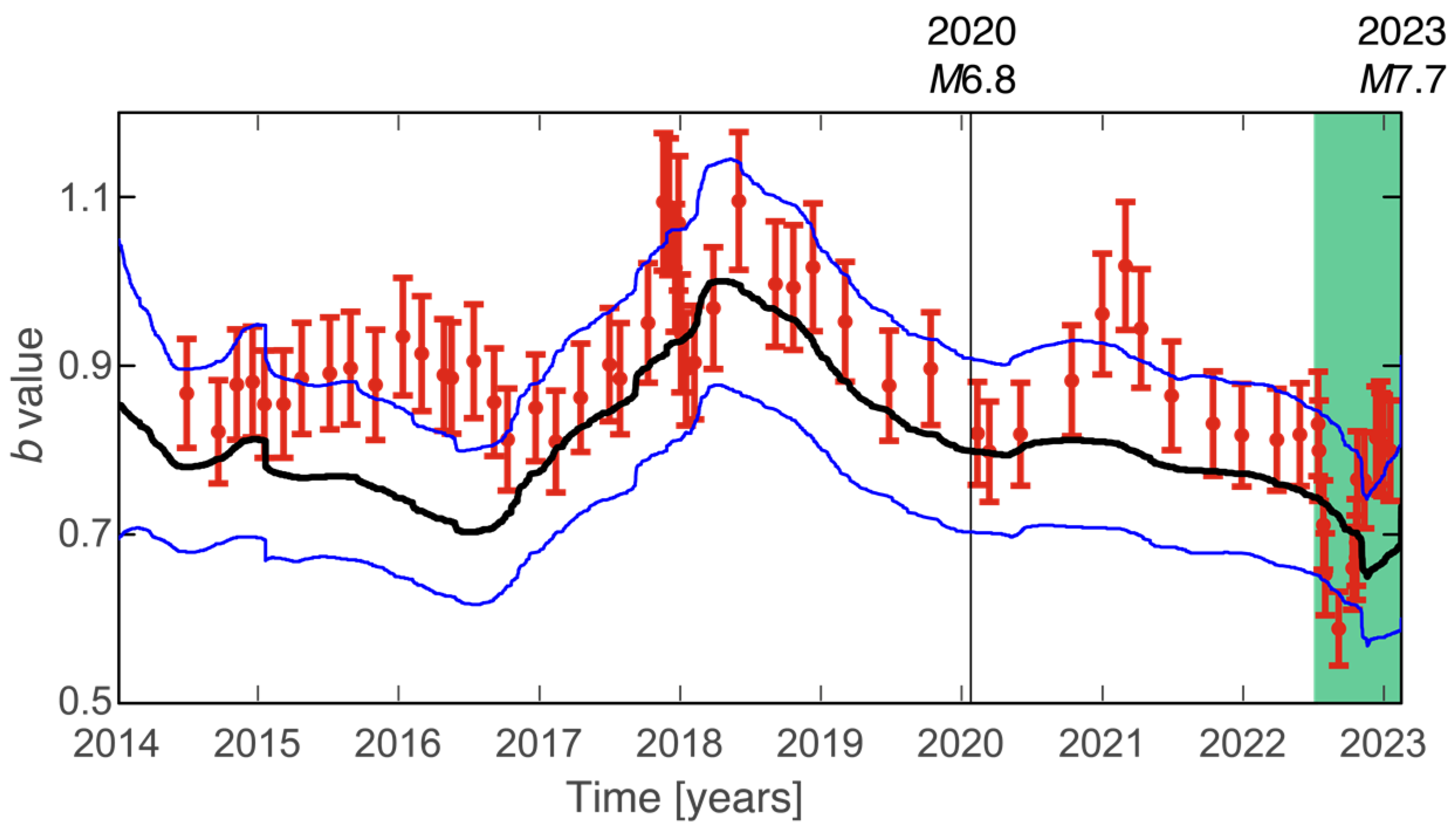
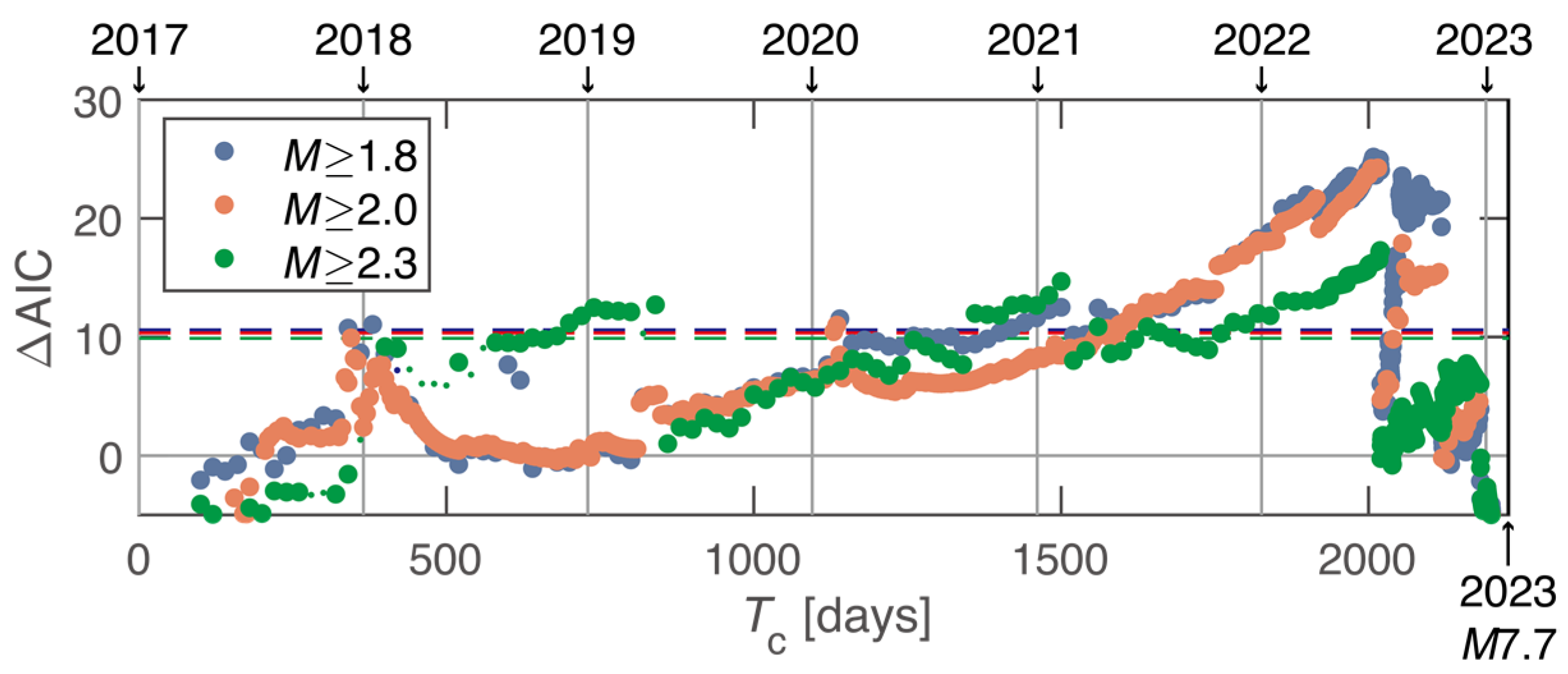
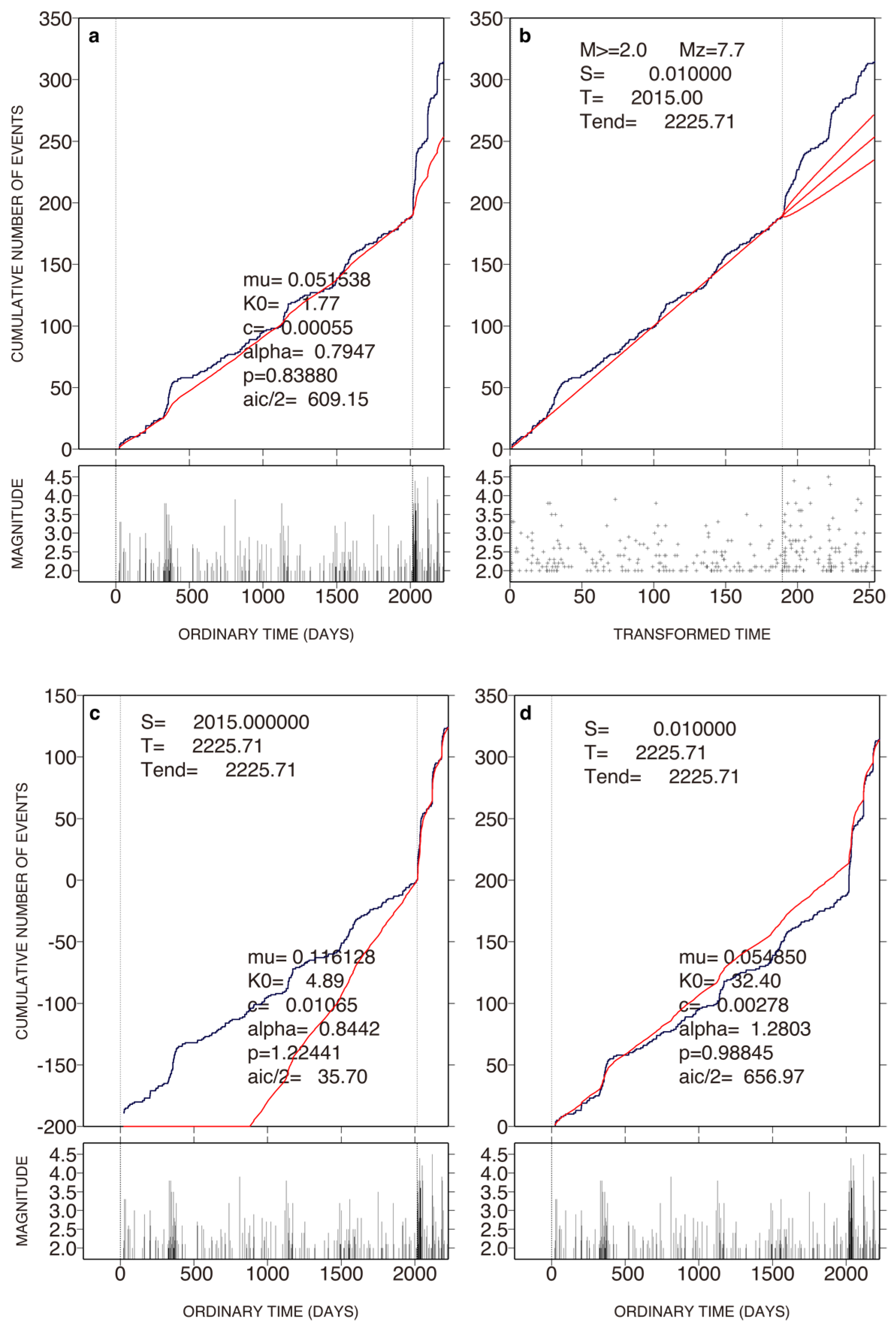
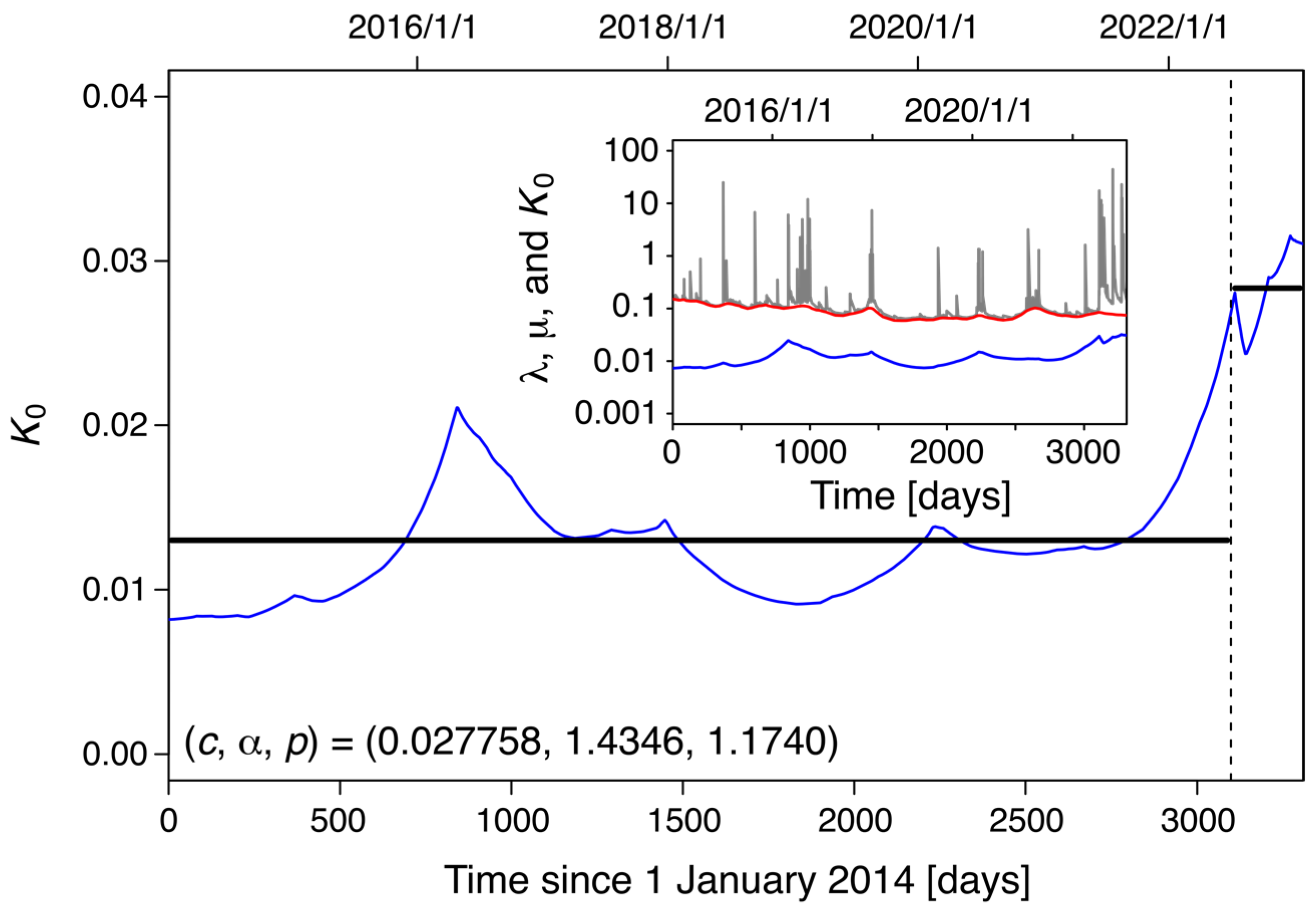
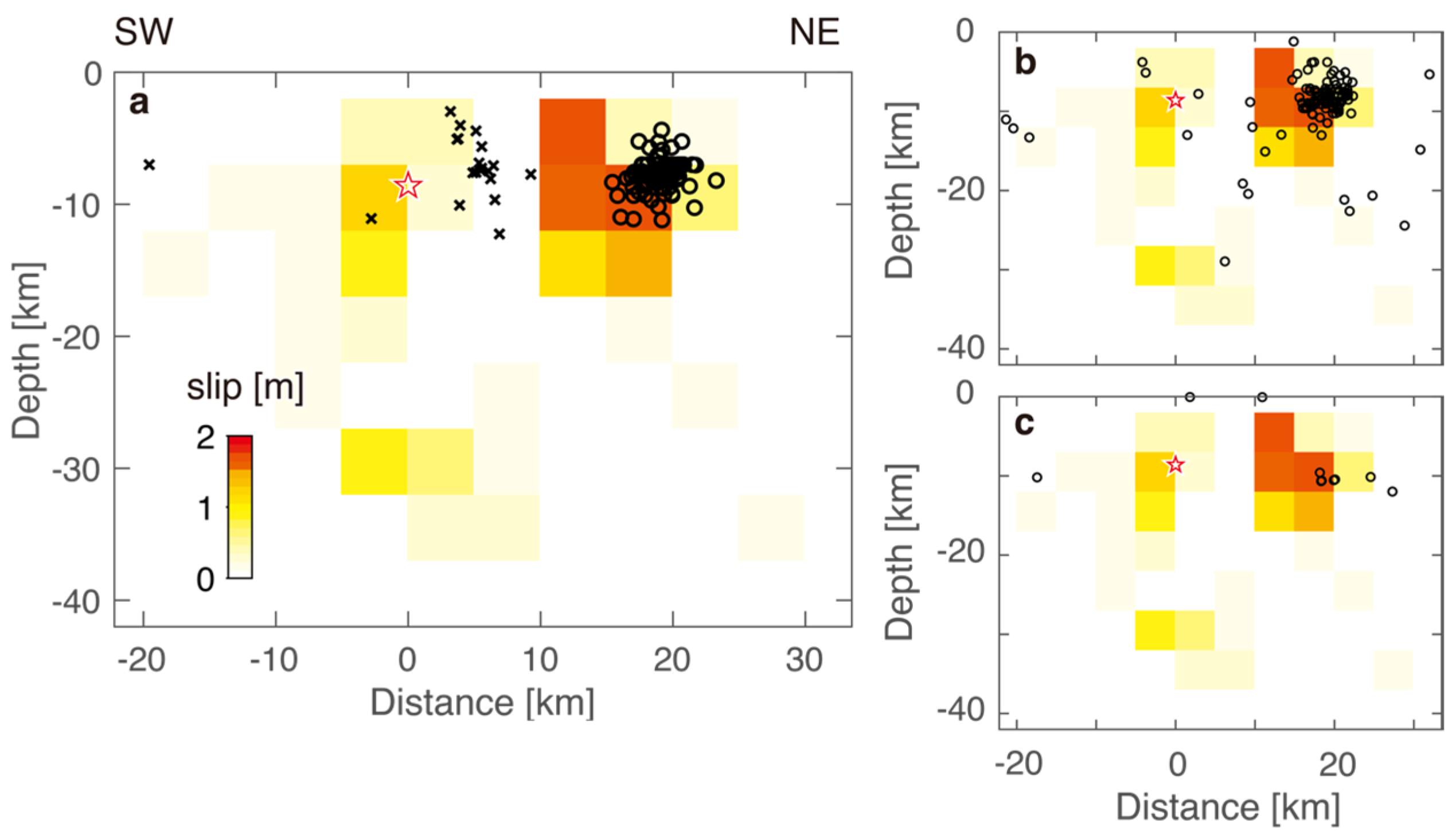
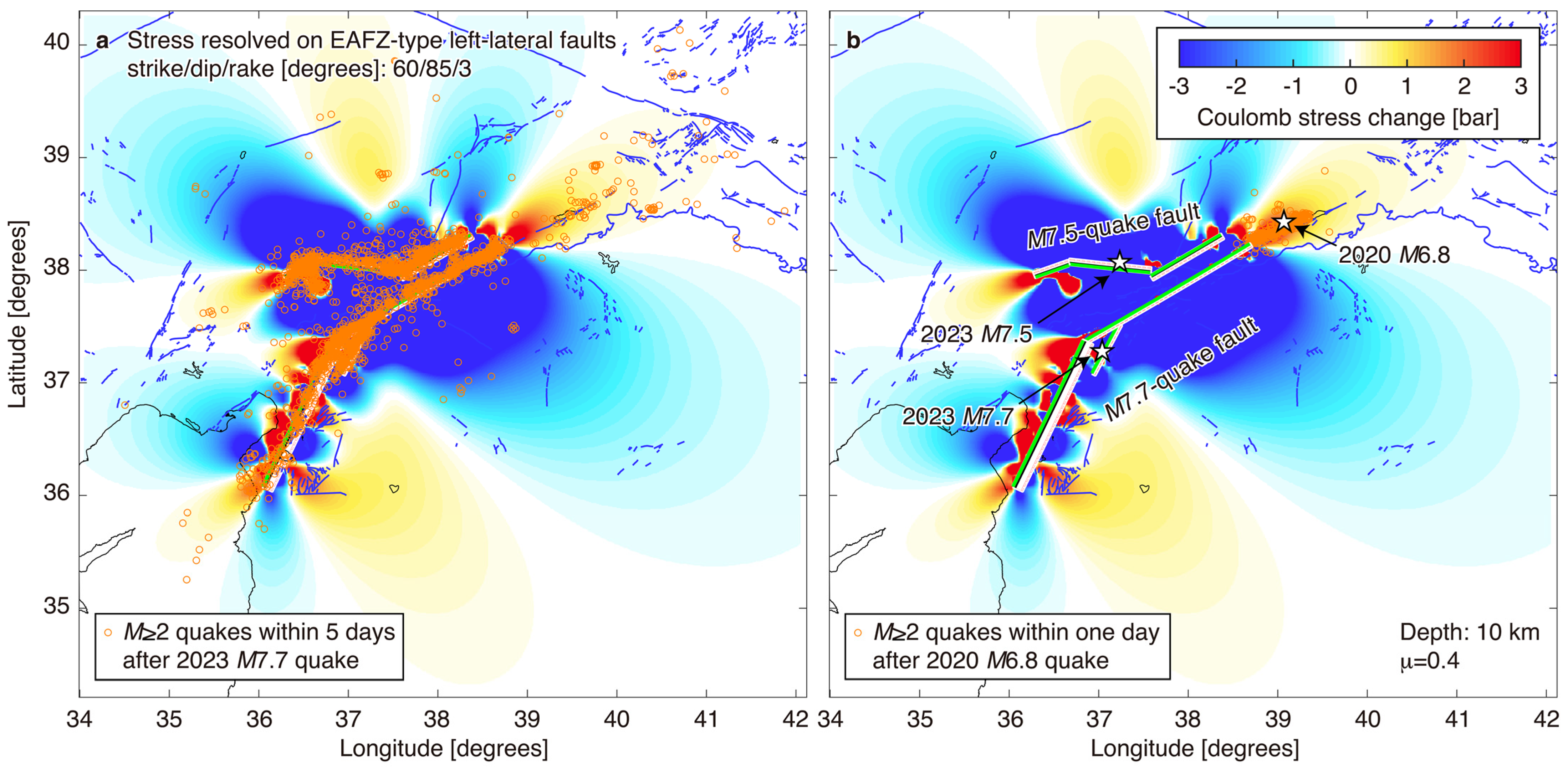
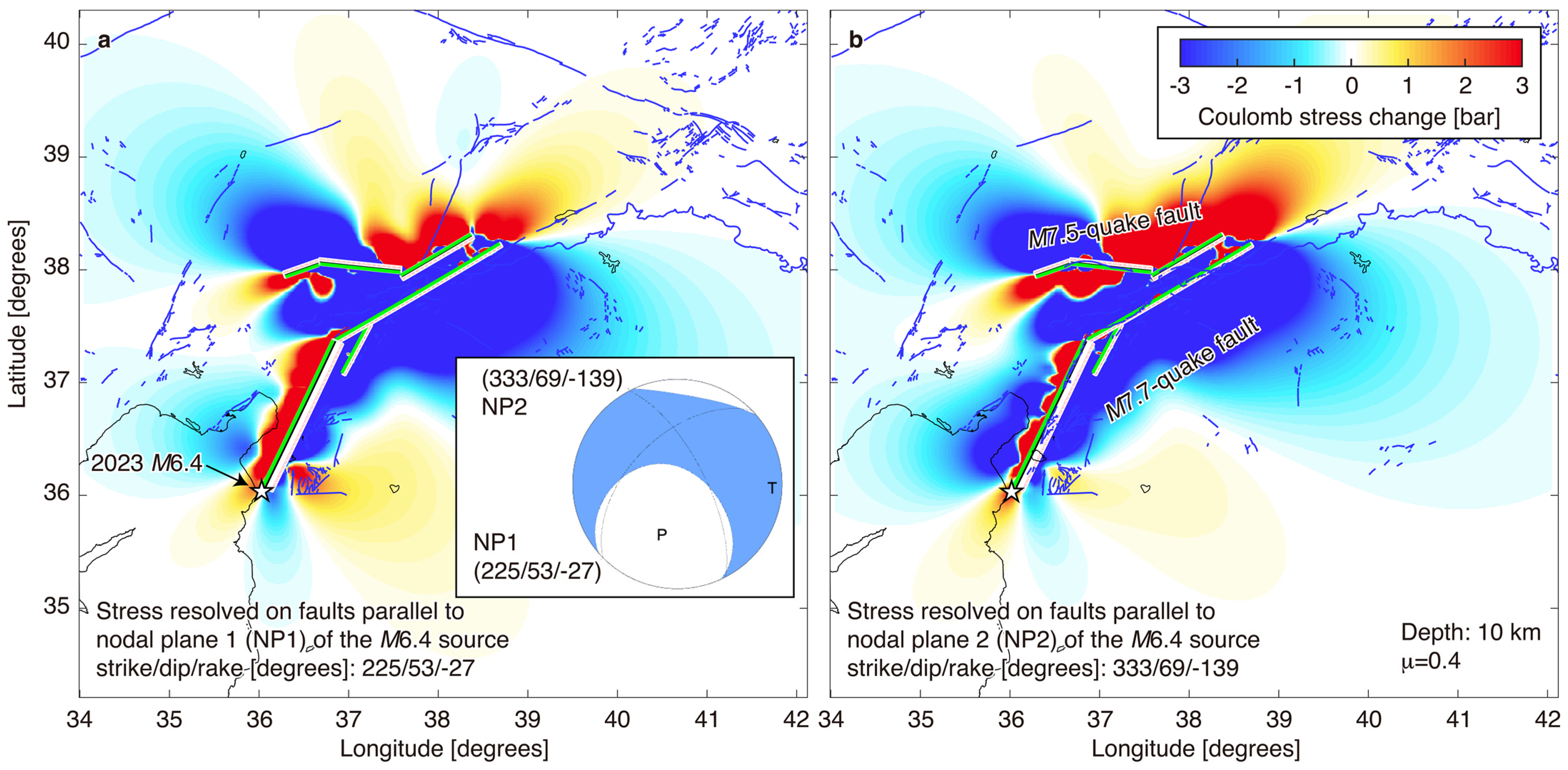
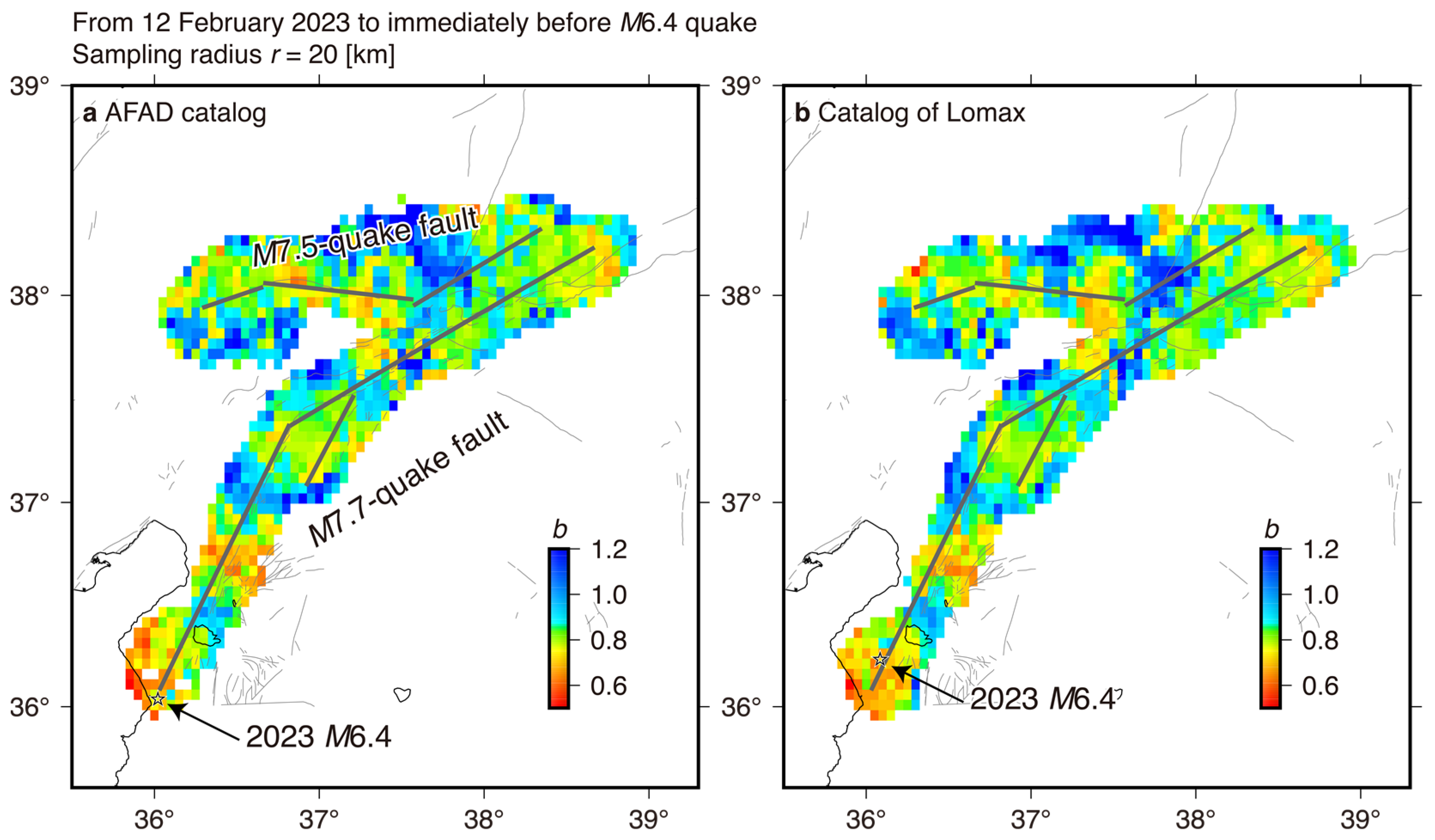

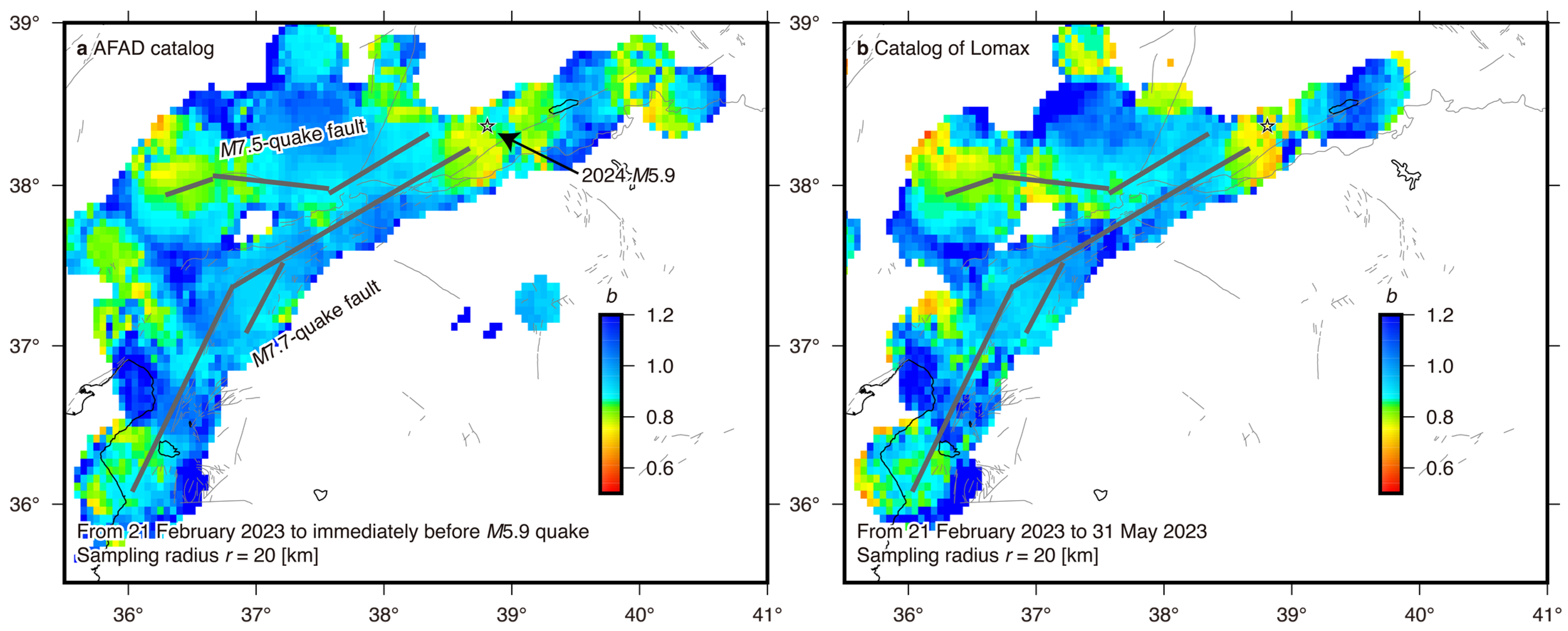
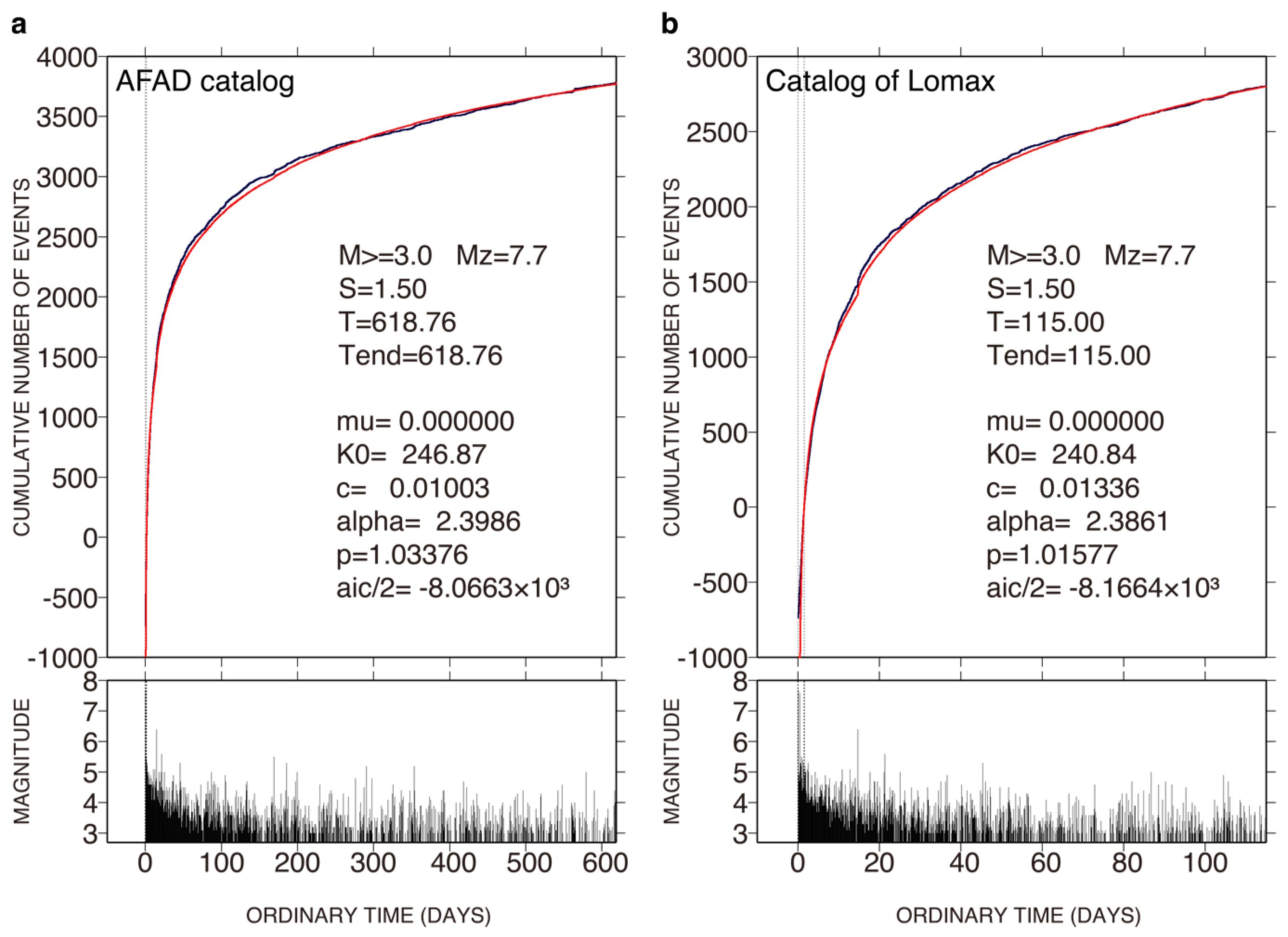

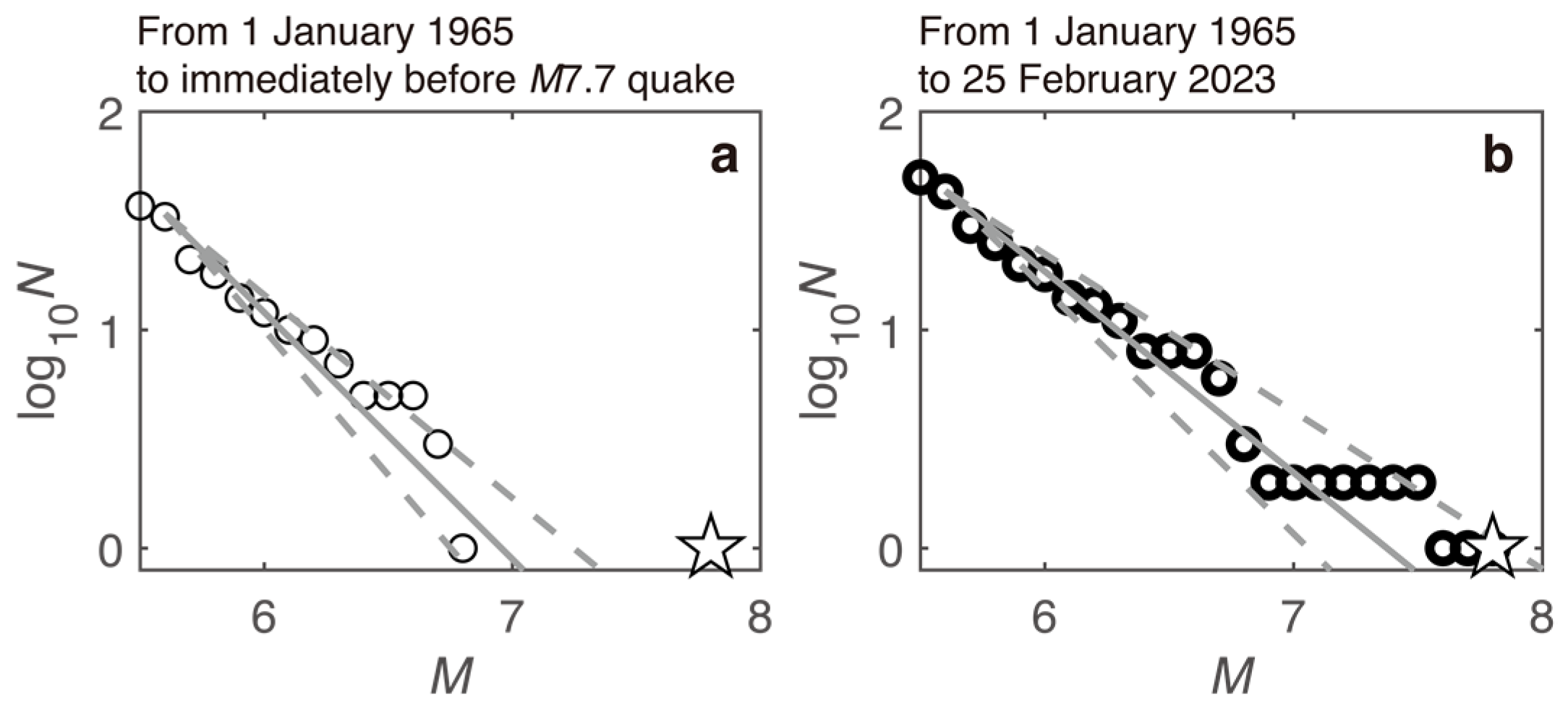
Disclaimer/Publisher’s Note: The statements, opinions and data contained in all publications are solely those of the individual author(s) and contributor(s) and not of MDPI and/or the editor(s). MDPI and/or the editor(s) disclaim responsibility for any injury to people or property resulting from any ideas, methods, instructions or products referred to in the content. |
© 2025 by the authors. Licensee MDPI, Basel, Switzerland. This article is an open access article distributed under the terms and conditions of the Creative Commons Attribution (CC BY) license (https://creativecommons.org/licenses/by/4.0/).
Share and Cite
Nanjo, K.Z.; Kumazawa, T.; Izutsu, J.; Hori, T.; Nagao, T.; Oike, K. Seismicity Before and After the 2023 M7.7 and M7.5 Turkey Quakes. Geosciences 2025, 15, 113. https://doi.org/10.3390/geosciences15040113
Nanjo KZ, Kumazawa T, Izutsu J, Hori T, Nagao T, Oike K. Seismicity Before and After the 2023 M7.7 and M7.5 Turkey Quakes. Geosciences. 2025; 15(4):113. https://doi.org/10.3390/geosciences15040113
Chicago/Turabian StyleNanjo, Kazuyoshi Z., Takao Kumazawa, Jun Izutsu, Takane Hori, Toshiyasu Nagao, and Kazuo Oike. 2025. "Seismicity Before and After the 2023 M7.7 and M7.5 Turkey Quakes" Geosciences 15, no. 4: 113. https://doi.org/10.3390/geosciences15040113
APA StyleNanjo, K. Z., Kumazawa, T., Izutsu, J., Hori, T., Nagao, T., & Oike, K. (2025). Seismicity Before and After the 2023 M7.7 and M7.5 Turkey Quakes. Geosciences, 15(4), 113. https://doi.org/10.3390/geosciences15040113





